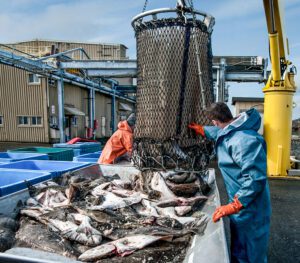
Global market forces, the low value of the Russian ruble, a trade war with China, large pink salmon harvests and high inflation have led to historically low prices paid to harvesters and processors across multiple seafood species harvested in Alaska.
Now economists with the Alaska Department of Labor say much of what happens in Alaska’s upcoming fishing season depends on how many potential processing facility sales actually go through before the season begins.
“Long term there should be recovery, but it is hard to say how long it will take, because so many of these factors are external to Alaska and out of our control,” said state labor economist Sam Tappen, who authored an update on seafood processing sales and closures in Alaska with fellow economist Dan Robinson in the April edition of the magazine Alaska Economic Trends.
The article points out potential disruptions in employment in multiple facilities if sales of the facilities aren’t completed before harvesting begins. Tappen noted that some processors have said they would still ensure markets for salmon fishermen even if the sales don’t go through as planned.
Divestment announcements from major processors began in early December with a press release from Trident Seafoods, and ran through an announcement from OBI Seafoods at the end of January.
Trident announced it was seeking buyers for processing and related assets in the Alaska areas of Kodiak, Ketchikan, Petersburg, False Pass, South Naknek and Chignik, plus scaling back on winter operations in Kodiak this year.
Peter Pan Seafoods announced closure of its King Cove Plant for the 2024 “A” pollock season, which began in January and runs through April.
OBI officials said they would not open a summer fish processing plant in Larson Bay on Kodiak Island this year, but would still buy salmon from area harvesters.
In recent years, seafood processing has employed nearly 20,000 people during the peak of salmon processing, accounting for over $600 million in annual wages. The importance of this money to the state economy is amplified by the market it provides to tens of thousands of Alaska fishermen working mainly from coastal communities whose economies are dependent on the seafood industry.
Meanwhile, sales of many plants offered by processors are in process.
Trident announced in March that sales were nearly final for its False Pass, Petersburg and Ketchikan plants, which would mitigate the loss of processing capacity and buyers for the fishing fleet. Still, it’s clear that market forces have created a difficult environment for processors and harvesters.
The Economic Trends article notes that higher inflation has further reduced demand for Alaska seafood in domestic restaurants and stores. Higher interest rates, prompted by the Federal Reserve’s effort to bring inflation down, have made it harder for processors to secure financing to allow them to hold more product in inventory while they wait for better market prices.
These combined forces have led to historically low prices for harvesters and processors across multiple species harvested in Alaska, the economists said.
